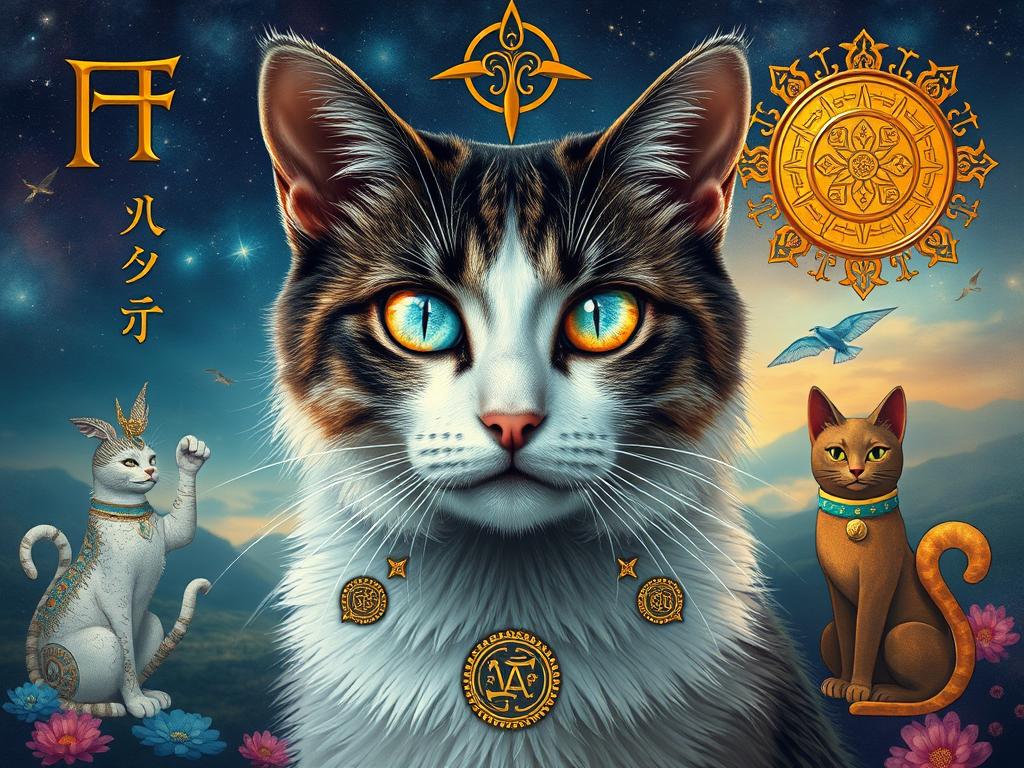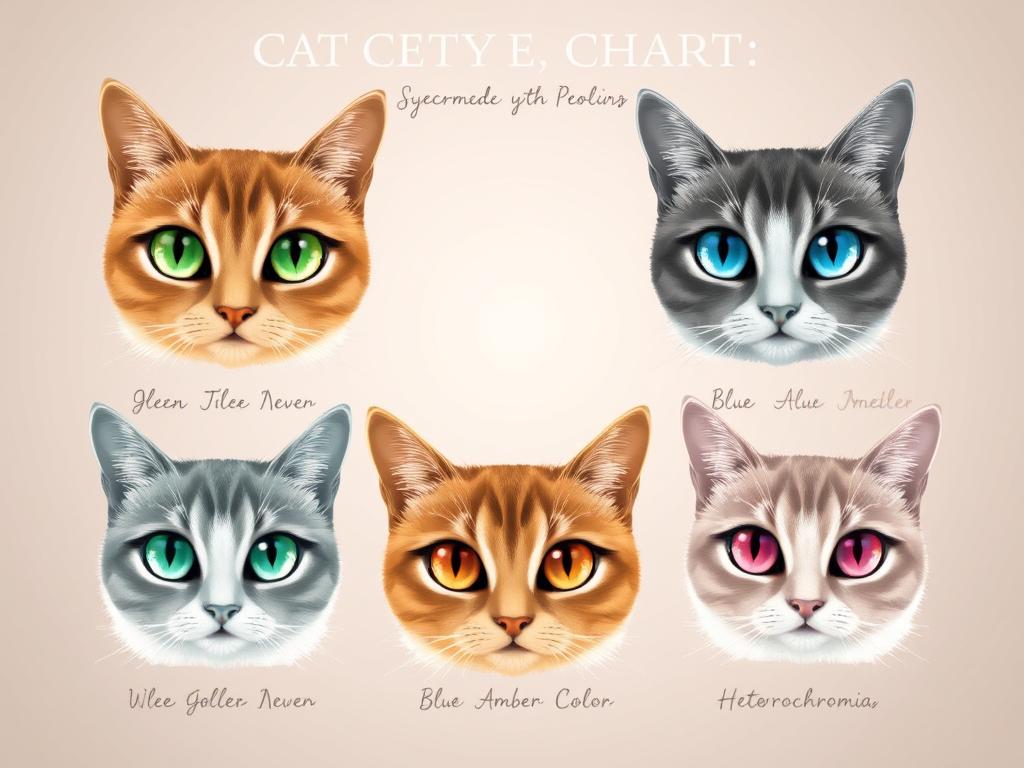“Affiliate Disclosure: Please note that some of the links on this website are affiliate links. This means that if you choose to make a purchase through these links, we may receive a small commission at no additional cost to you. This helps support the maintenance and continuation of our site. We assure you that we only recommend products or services we use personally or believe will add value to our readers. Thank you for your support.”
Did you know about heterochromia? It’s a rare condition where cats have two different colored eyes. It happens in about 1 in 1000 cats. This special trait catches the eye of many cat lovers. It shows us the amazing variety of eye colors cats can have due to genetics. These colors tell us more about their genetics and health.
This article takes you deep into the world of feline eye colors. You’ll understand how genetics create these beautiful features. We’ll look at how some breeds have unique eye colors. And we’ll explore the science behind why this happens. Let’s find out why cat eyes of different colors have fascinated people for so long.
Key Takeaways
- Heterochromia is a rare condition affecting about 1 in 1000 cats.
- Genetic factors significantly influence feline eye color variations.
- Certain breeds display unique eye characteristics more frequently.
- Colors like green, yellow, and copper are common in cats.
- The presence of the white gene impacts eye color in various breeds.
- Kittens are born with blue eyes that may change as they mature.
The Fascinating World of Cat Eye Colors
The world of cat eye colors is amazing, covering many hues. These range from common yellow and green to rare blue and copper shades. The colors of a cat’s eyes tell us about their genes and health. Each hue has its own significance, hinting at genetic traits or health conditions.
Certain unique eye colors make cats stand out. For instance, about 1 in 1000 cats might have heterochromia. This means they have eyes of two different colors, or two colors in one eye. It’s often seen in white cats or those of certain breeds like Turkish Van and Khao Manee.
Genetics play a big role in a cat’s eye color. Some cats with a special gene have striking blue eyes. Others might show a mix of colors like green, amber, or copper. These rare colors highlight the complex biology of cats.
Looking into cat eye colors, you find an amazing variety. This adds to the special bond between pets and their owners. Cat eyes fascinate animal lovers everywhere, drawing attention from across the world.
Genetics Behind Cat Eye Colors
The world of cat eye colors is fascinating. It’s all about the genes that make so many colors possible. We see how gene processes link to the beauty of cat eyes. It starts with melanin, which gives color to cat fur and eyes. This section looks into how melanin influences eye color across breeds.
How Melanin Influences Eye Color
Melanin creates the colors in cat eyes in various ways. All kittens start with blue eyes due to little melanin. As they grow, melanin cells spread and change, setting their final eye color. Cats can have different eye colors, like:
- Blue: Comes from low melanin, common in Siamese cats.
- Green: Made by the yellow pigment lipochrome, often in mixed-breed cats.
- Amber: From mixing green and orange pigments, seen in many domestic cats.
- Yellow: Also from lipochrome, found in some breeds.
- Copper: Mostly in Abyssinians.
Genetic Factors in Different Breeds
Different cat breeds have their own eye color genes. For example, 40% of Siamese cats keep their blue eyes as adults. Mixed breeds, with their varied genes, often have green eyes, about 30% of them. Each breed brings something special:
| Breed | Common Eye Colors | Percentage of Breed |
|---|---|---|
| Siamese | Blue | 40% |
| Turkish Van | Odd-eyed (one blue, one amber) | 60% |
| Abyssinian | Copper | 10% |
| Mixed Breed | Green | 30% |
| Domestic Cats | Various colors | Inclusive of all hues |
Understanding these genetics deepens our appreciation for the variety of cat eyes in different breeds.
What Is Heterochromia in Cats?
Heterochromia in cats is when a cat has eyes of different colors. It’s more common in cats than in many other animals. This makes it a very interesting subject for cat lovers. The beauty of cats with heterochromia also sparks curiosity about their genes.
Types of Heterochromia: Complete vs. Sectoral
There are two main kinds of heterochromia: complete and sectoral. Complete heterochromia means a cat has two completely different eye colors. This creates a striking look. Sectoral heterochromia shows multiple colors in one iris, mixing shades beautifully. Both types highlight the amazing variety of cat eye colors.
Common Breeds with Heterochromia
Some cat breeds are more likely to have heterochromia. Let’s look at a few:
| Breed | Description |
|---|---|
| Turkish Van | A rare ancient breed often showing a mix of white and colored fur, with distinct eye colors. |
| Khao Manee | Typically white, known for their historical significance in Thailand and association with heterochromia. |
| Turkish Angora | Solid white with a genetic predisposition for heterochromia, celebrated for their beauty. |
Knowing which breeds often have heterochromia adds to their allure. This feature is usually seen in white-coated cats, due to a special gene.
Common Cat Eye Colors and Their Meanings
The world of cat eye colors is fascinating. Each color offers a glimpse into a cat’s traits and genetics. By understanding these colors, you can feel closer to your feline friends.
Yellow and Amber Eyes: Traits and Breeds
Half to sixty percent of all cats have yellow or amber eyes. These eye colors usually mean the cat is warm and friendly. The Bengal and Burmese breeds are well-known for these eye colors. Unusual colors like orange or amber are considered more rare.
| Breed | Eye Color | Personality Traits |
|---|---|---|
| Bengal | Yellow | Energetic, playful |
| Burmese | Amber | Affectionate, social |
Green Eyes: Significance and Genetics
About 10-15% of cats have green eyes. Russian Blue and Egyptian Mau breeds often have this eye color. Cats with green eyes are sometimes seen as playful and quick. The Egyptian Mau is especially fast and has beautiful green eyes.
Blue Eyes: The Rarity and Beauty of Blue
Blue-eyed cats are quite rare, making up only 3-5% of cats. The Siamese and Ragdolls are famous for their blue eyes. These cats often have white fur because the same gene affects both fur and eye color. Interestingly, a high percentage of white cats with blue eyes are deaf.
Cat Eyes of a Different Colour
The beauty of multi-colored cat eyes is truly something special. This phenomenon shows the wide range of colors that cat eyes can have. It tells us a lot about the unique genes of these animals. Learning about the unique cat eye colors teaches us to appreciate our furry friends even more.
Understanding Multi-Colored Cat Eyes
Multi-colored cat eyes come from a condition called heterochromia. It makes some cats have eyes that are different colors. Cats with this trait are very special. They have it more often than people do. Breeds like the Khao Manee and Turkish Angora are famous for their beautiful eyes. These cats are loved all over the world because of their eyes.
Fascinating Facts About Exotic Eye Shades
Cats can have one blue eye and one green or copper eye. They can even have eyes with more than one color. Cats with these eyes carry diverse genes. Let’s look at some interesting facts about their eye colors:
- Complete heterochromia means a cat has one blue eye and another eye of a different color.
- Partial heterochromia shows two colors in one iris, which looks amazing.
- Central heterochromia has a different color around the pupil, making it stand out.
- The Khao Manee, with its eye-catching eyes and white coat, is very popular.
- Some breeds, like the Siberian Husky and Australian Shepherd, can have these eye traits in both cats and dogs.
Rarity of Unusual Cat Eye Colors
Cat eyes come in an impressive range of colors. Some of these colors are much rarer than others. Understanding these rare colors can show us more about cat genetics and what makes them look so special.
Identifying Rare Colors in Cats
Finding rare cat eye colors involves looking for unusual shades. Amber, hazel, and dichroic eyes are examples of rare colors. Each rare color has a score showing how common it is among cats. Here’s more information about these unique eye colors:
| Eye Color | Rarity Score | Dominant Color | Typical Coat Colors | Popular Breeds |
|---|---|---|---|---|
| Amber | 2/10 | Yellow | Black | Somali, Cornish Rex, Burmese |
| Hazel | 3/10 | Brown | Beige, Brown, Black, Yellow | Bobcats, Bengal, Lynx |
| Brown | 5/10 | Brown | Brown, Black, Ginger | American Shorthair, British Shorthair, Manx |
| Orange | 6/10 | Orange | Black, Ginger, White | Devon Rex, Maine Coon, Japanese Bobtail |
| Odd | 9/10 | Mix (Blue/Yellow, Hazel, Green, Copper) | White, Grey, Ginger, Black | British Shorthair, Munchkins, Persians, Japanese Bobtails, Siamese |
| Dichroic | 10/10 | Mix (Green, Yellow, Blue, Brown, Amber) | None Specified | None Specified |
Popular Breeds with Uncommon Eye Shades
Some cat breeds are famous for their unique eye colors. This feature adds to their charm and rarity. For example, the British Shorthair is known for its odd-colored eyes. The Siamese is admired for its deep blue eyes. Let’s look at a few breeds with special eye colors:
- Burmese – Known for its striking amber eyes.
- Turkish Van – Notable for its odd-eyed traits.
- Bengal – Often showcases hazel eyes.
- Devon Rex – Frequently seen with orange eyes.
How Eye Color Changes With Age
Kittens’ eye colors change a lot as they grow. These changes are key for cat eye care and spotting health issues. Their initial eye colors are striking but change as they grow up. Changes in eye color can also signal health issues.
Developmental Changes in Kittens
Kittens have bluish eyes at birth. They have no pigment, which makes the color seem different. For the first 8 to 12 days, they can’t open their eyes. By 7 weeks, their true eye colors start to show, ranging from green to gold. If their eyes are still blue after 10 weeks, they’ll likely stay that way. Gold, yellow, and greenish-yellow are common in adults. Blue is rarer and often seen in white cats.
Health Implications of Sudden Eye Color Changes
In adult cats, eye color usually doesn’t change much. But big, sudden changes can mean health problems that need a vet right away. Issues can include uveitis, jaundice, glaucoma, and cataracts. Watch out for redness, cloudiness, extra tears, and discharge. Diseases like glaucoma can change the iris color and cause vision loss if ignored. It’s important to keep an eye on these changes to help keep your cat healthy.
| Eye Color | Commonly Seen In | Health Implications |
|---|---|---|
| Blue | White Cats | Higher risk of congenital deafness |
| Green | Multiple Breeds | Normal, no significant health concerns |
| Gold/Yellow | Various Breeds | Generally normal, varies in intensity |
| Copper | Black Cats | Can indicate liver defects |
| Amber | Sphynx, Bengals, Norwegian Forest | Rare, typically no associated health issues |
| Heterochromia | Turkish Van, Khao Manee | Rarity; potential genetic implications |
The Cultural Significance of Cat Eye Colors
Throughout history, cat eye colors have fascinated people around the world. They carry deep meanings and beliefs in many cultures. The unique hues of cat eyes are wrapped in stories, myths, and superstitions.
Heterochromia, where a cat has two different eye colors, is especially captivating. It has made people curious and admire these cats. They link them to luck and mystical elements.
Heterochromia in Mythology and Folklore
Mythology links heterochromia to magic and power. Cultures see these cats as lucky signs with supernatural powers. Ancient people thought cats were sacred. They saw unusual eye colors as divine gifts.
In some tales, meeting a cat with different eye colors could mean good luck or a big change. This has kept our interest in cat symbolism alive in today’s culture.
Superstitions Surrounding Odd-Eyed Cats
Superstitions about odd-eyed cats stand out. People view them with wonder and some wariness. They’re said to bring both good and bad luck, depending on the situation.
Some beliefs connect these cats to protective spirits or shapeshifting beings from myth. These stories keep us fascinated by their intriguing eyes and the secrets they might hold.

| Cultural Context | Belief or Superstition |
|---|---|
| Ancient Egypt | Eye of Ra – cats symbolize protection and divinity |
| Japanese Folklore | Odd-eyed cats are said to attract good fortune |
| European Traditions | Belief in the ability to ward off evil spirits |
| Middle Eastern Cultures | Odd-eyed cats are viewed as guardians against misfortune |
Caring for Cats with Unique Eye Colors
Cats with unique eye colors need special care to keep their eyes healthy. It’s more than just about looks. Regular vet visits are important for their vision and eye health. Also, it’s vital to know if their breed might have eye issues, as some do.
Maintaining Eye Health in Cats
To keep your cat’s eyes healthy, follow these guidelines. This ensures they are happy and have good vision.
- Look for redness, discharge, or cloudiness in their eyes regularly.
- Keep their eye area clean to avoid infections.
- Feed them a diet with vitamins A and E to support vision.
- Watch for any fast changes in their eye color, as it can mean health problems.
- Play with them often to keep them active and healthy.
Regular Check-ups: When to See a Vet
Vet visits are key to keeping an eye on your cat’s vision. Here’s when to schedule one:
- If you see unusual tears or goop from the eyes.
- When they squint a lot or don’t like light.
- Any new behavior or if they seem in pain.
- Quick changes in the color of their eyes could mean trouble.
- If they might have cataracts, especially as they get older.
By paying attention to their eye health and seeing the vet when needed, you can keep your special-eyed cat in great shape.
Conclusion
Exploring cat eye colors has shown us the beauty and science behind their shades. We’ve learned how genes create different colors and how those colors contribute to a cat’s breed and cultural importance. Every eye color has a story, connecting us more to these amazing animals.
Eye color in cats can also show us their health status. If a cat’s eye color changes, it might mean a health problem that needs checking. Knowing what to look for helps us keep our pets healthy and happy.
Understanding cat eye colors brings us closer to our pets. Whether their eyes are deep blue or have heterochromia, each color adds to their uniqueness. Our journey into cat eye colors shows us the beauty and the science in our cats’ lives.





